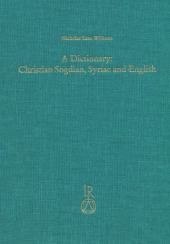 Neuerscheinungen 2016Stand: 2020-02-01 |
Schnellsuche
ISBN/Stichwort/Autor
|
Herderstraße 10
10625 Berlin
Tel.: 030 315 714 16
Fax 030 315 714 14
info@buchspektrum.de |

Nicholas Sims-Williams, Nicholas Sims- Williams
(Beteiligte)
A Dictionary: Christian Sogdian, Syriac and English
2016. 408 S. 24 cm
Verlag/Jahr: REICHERT 2016
ISBN: 3-9549017-5-7 (3954901757)
Neue ISBN: 978-3-9549017-5-3 (9783954901753)
Preis und Lieferzeit: Bitte klicken
"Nicholas Sims-Williams hat sich mit [dem vorliegenden Wörterbuch] [...] erneut um die Erschließung des Sogdischen verdient gemacht."
Von: Rüdiger Schmitt
In: Kratylos, Jahrgang 62 (217), S. 227-232.
Many works of Syriac literature, including some now lost, were translated into Sogdian, a language of the Iranian family. The present Dictionary makes this material accessible to both Iranists and Syriacists, giving a full semantic and morphological analysis of the attested Christian Sogdian vocabulary. The first part, arranged by Sogdian lemmata, also indicates the various Syriac words which each Sogdian form translates, while the second part, arranged by Syriac lemmata, shows all possible ways of translating any Syriac word into Sogdian. A comprehensive English index adds to the utility of the work.
Many works of Syriac literature were translated into Sogdian, a Middle Iranian language originating in the region of Samarkand and widely spoken along the so-called "Silk Road". This Christian Sogdian literature, which includes biblical, liturgical, ascetic and hagiographic texts, is chiefly known from a cache of manuscripts discovered in 1905 at the site of the ruined monastery of Bulay‹q in the Turfan oasis. It is important for Syriac studies, since the Sogdian translations were often made on the basis of earlier recensions than those which survive in Syriac and since some texts are no longer extant in Syriac. It is no less important for Sogdian and Middle Iranian studies, since those texts whose Syriac originals can be identified provide a firm basis for the understanding of the Sogdian language; moreover, the material in Syriac script, with its elaborate system of vocalic points, is a unique source of information on the pronunciation of Sogdian.
The present Dictionary is designed to be accessible both to Iranists, whether or not they know Syriac, and to Syriacists, whether or not they know Sogdian. It consists of two main sections followed by a comprehensive English index. Part 1, arranged by Sogdian lemmata, provides a complete listing of all words attested in published Christian Sogdian texts, both in Syriac and in Sogdian script, including variant spellings, full parsing of all inflected forms, and details of their equivalents in the most closely corresponding Syriac parallel text. In Part 2 the same material is arranged by Syriac lemmata. The two parts together make it possible to see what Syriac form or forms any Sogdian word can represent and how any Syriac word or idiom is translated into Sogdian. The dictionary thus fulfils a range of functions. Firstly, it will provide a reliable guide for anyone who wants to read the extant Christian Sogdian texts; secondly, it will assist future editors in identifying, restoring and translating Christian Sogdian texts; and thirdly, it will contribute to the study of the transmission of literature from Syriac into Sogdian and the techniques of the translators.


